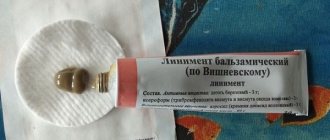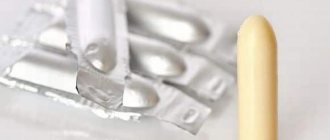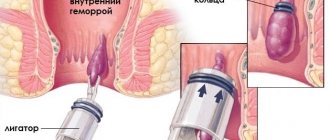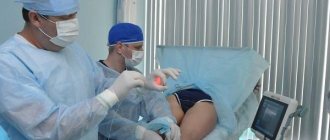Published 05/19/2020 · Comments: · Reading time: 8 min · Views: Post Views: 4,491
Hemorrhoids are the result of varicose veins in the rectum. With this pathology, internal or external nodes are formed from affected venous vessels. The disease develops gradually and eventually becomes chronic.
In the early stages, medication has an involutional effect. Surgical removal of hemorrhoids is resorted to when conservative treatment does not give the desired result. Depending on the severity of the process, the proctologist chooses one of the modern methods of radical removal of hemorrhoids.
Types of operations to remove hemorrhoids
Today, in the radical treatment of hemorrhoids, preference is given to two operations - hemorrhoidectomy and hemorrhoidopexy.
Both types of surgery require a careful preparation period, since they are performed under general anesthesia.
Surgery to remove hemorrhoids according to Milligan-Morgan
Hemorrhoidectomy, or Milligan-Morgan operation, is the complete removal of hemorrhoids along with part of the rectal mucosa. This method is rightfully considered the most effective, but has a number of disadvantages, including a painful and long rehabilitation period.
There are two types of hemorrhoidectomy - closed and open. With closed hemorrhoidectomy, the edges of the surgical wound are sutured with catgut threads, and with open hemorrhoidectomy, they are left untouched for self-tightening. Accordingly, the second type of operation is more painful and has a longer recovery period.
The Milligan-Morgan operation is performed only in a surgical hospital under general anesthesia. The stay in the surgical department takes on average 10 days, and the recovery period after surgery is 3 - 4 weeks.
Operation Longo
Hemorrhoidopexy or Longo's operation is the pulling of hemorrhoids into the anus by cutting out a circular section of the mucous membrane of the rectal canal above the varicose cavernous veins. Also, during surgery, the vessels supplying blood to the hemorrhoids are sutured, as a result of which they collapse and disappear.
The duration of such a surgical intervention is no more than 20 minutes, and the rehabilitation period is from 1 to 2 weeks. This operation can, and is most often, performed under epidural anesthesia.
Possible complications
Surgical intervention to remove hemorrhoids in any of the options can have complications that arise several hours or days after the operation, as well as months later. The most common negative consequences that occur immediately after the intervention are:
- severe pain that requires the prescription of painkillers, including narcotics. In the rectum, in the area around the anus, a large number of nerve endings are concentrated. Therefore, it is natural that after the end of anesthesia, patients experience severe pain. If the threshold of pain sensitivity is low, this is real torture;
- urinary retention in the first days after surgery , especially in older men. The risk of development increases with the use of epidural anesthesia. The problem is solved by catheterization;
- psychogenic constipation (fear of suture dehiscence, artificial inhibition of defecation) - corrected by selecting an individual diet, laxatives; for sphincteral spasm, the use of nitroglycerin ointment is indicated;
- bleeding - possible at any stage of rehabilitation, due to improper suturing, the appearance of anal fissures or injury to the mucous membrane of the rectal canal with feces. You can stop the bleeding using local drugs with adrenaline, a hemostatic sponge, or re-stitching of bleeding vessels;
- suppuration of the sutures is the result of non-compliance with intimate hygiene, the addition of a secondary infection, it is corrected by antibiotic therapy, the use of local disinfectants (Levomekol, ichthyol ointment, Vishnevsky ointment). In severe cases, opening and washing the festering wound is indicated.
Delayed complications can be considered:
- fistula tracts are the result of infection of the subcutaneous fat with the development of inflammation and suppuration: the issue can only be resolved promptly. The complication is dangerous due to the development of sepsis;
- narrowing of the anus is the result of incorrect suturing, corrected by mechanical expansion over a long period of time or anal plastic surgery;
- weakness of the anal sphincter , prolapse of the rectal mucosa - occurs as a result of injury to the nerve endings located in the anus. Most often, the functioning of the sphincter is restored with the help of medication; in severe situations, surgery is required.
Almost all complications depend on the qualifications of the surgeon or the individual characteristics of the patient.
Surgery to remove hemorrhoids: indications for performance
Surgery to remove hemorrhoids, despite some disadvantages, is today the only radical method of treating this disease.
Main contraindication? to perform radical surgery for hemorrhoids – advanced forms of the disease that do not respond to conservative therapy. Also, a specialist may raise the question of removing hemorrhoids in cases where there are complications that pose a potential danger to the health and life of the patient.
Thus, the following indications for hemorrhoid surgery can be distinguished:
- constant bleeding, which can cause anemia or even hemorrhagic shock;
- inflammation of the tissues of the anorectal area, provoked by the constant sagging of hemorrhoids through the anal ring;
- risk of strangulation of hemorrhoids in the anus;
- tendency to thrombosis of hemorrhoids;
- development of anorectal thrombosis;
- second stage hemorrhoids, complicated by paraproctitis or fistulas;
- subcutaneous and submucosal hemorrhoids of the third stage, subject to the presence of large hemorrhoidal cones;
- subcutaneous and submucosal hemorrhoids of the fourth stage;
- combined hemorrhoids of any stage;
- lack of positive dynamics from conservative therapy;
- ineffectiveness of minimally invasive surgical methods for treating hemorrhoids.
In addition, radical surgery to remove hemorrhoids can be performed at the request of the patient, regardless of the stage of the disease.
Minimally invasive techniques (bloodless operations)
Innovative methods for removing hemorrhoids with minimal penetration into the rectal cavity are used more and more often in modern proctology, since they have undoubted advantages:
Coloproctologist
- minimal impact on the tissues adjacent to the inflamed hemorrhoids;
- short duration of the procedure (no more than half an hour);
- almost complete absence of pain when using local anesthesia (no anesthesia required);
- the patient does not need an inpatient rehabilitation period, returns home on the day of surgery, starts work the next day;
- minimally invasive techniques do not leave scars and do not deform the rectum or anus;
- the absence of serious contraindications suggests the use of a minimally invasive technique for removing hemorrhoids in older patients with many concomitant diseases;
- The low invasiveness of the techniques allows them to be used at any stage of hemorrhoidal disease.
Minimally invasive techniques are not included in the Territorial Compulsory Health Insurance Program, are not paid for under the compulsory medical insurance policy, and are carried out on a paid basis.
Today, a number of such innovations are used:
- Desarterization is the most effective method of non-surgical removal of hemorrhoidal cones. The essence is ligation of the arteries supplying the cavity through an anoscope, after preliminary determining the location of each vessel using ultrasound. The result is the exclusion of hemorrhoids from the general nutritional system of the anorectal zone with their subsequent death. The procedure provides a 95% cure rate, guarantees no relapses, but is expensive due to the equipment used. Prices in Moscow: from 14,800 rubles to 91,700 rubles (depending on the number of knots to be tied, the qualifications of the surgeon, the status of the clinic);
- Latex ligation is the second most effective procedure: more than 90%. The essence is the exclusion of hemorrhoidal formation from the bloodstream after placing a latex ring on the leg of the node, which gradually contracts. After a couple of weeks, the internal hemorrhoid dies and is removed naturally along with the ring. Minus - only internal bumps are indicated. In addition, while the ring is being tightened, the patient may feel a foreign body in the anus. The cost of ligation in Moscow: from 2,400 rubles (for one node) to 18,000 rubles;
- Sclerotherapy is the elimination of hemorrhoids by injecting a special drug into the node, which glues the walls of the cone itself and the vessels that feed it. Blocking power leads to the death of hemorrhoids. The procedure is quick and painless. Minus - applicable only for internal hemorrhoids, excluded in case of individual intolerance to the sclerosant drug, recurrence is possible, since the cause of the disease is not eliminated. Prices for sclerotherapy in Moscow: from 1,500 rubles to 13,200 rubles, depending on the number of nodes removed;
- Laser coagulation is indicated for hemorrhoids of any location. The essence is the effect of the laser on the entire venous cavity, which causes coagulation of proteins in the walls of blood vessels and cones. The veins and arteries are soldered together, the nutrition of the caverns stops, the nodes disappear without bleeding within a couple of weeks. Cost of the procedure in Moscow: from 12,000 to 18,000 rubles (for 1 hemorrhoid);
- Infrared photocoagulation - exposure of the cavity pedicle to a beam of focused infrared light with coagulation of proteins in the walls of blood vessels, blocking normal nutrition. The procedure requires several sessions. It is used mainly in the first stage of hemorrhoidal disease. The procedure is comfortable and painless, but often causes relapses. Prices in Moscow: from 1,000 to 25,000 rubles.
- Cryodestruction is the freezing of hemorrhoids with liquid nitrogen (temperature below 180-200 C), which affects only the damaged areas, since healthy areas through the arteries create a thermal “border” that prevents the penetration of cold into nearby tissues. Dead cells leave the rectum in about a week. Cryodestruction is painless, leaves no scars, and does not cause bleeding. But it stimulates the immune system. Contraindications include thrombosis or necrosis of the node, progressive proctitis and paraproctitis. The procedure is not performed on pregnant and nursing mothers. In Moscow and large regional centers, the price for manipulation is 4,000 – 8,000 rubles. In the regions, the cost is slightly lower: from 3,000 to 6,000 rubles. Cryodestruction surgery is performed extremely rarely.
It should be noted that minimally invasive intervention is justified, justified, advisable only with a highly qualified proctologist surgeon who removes hemorrhoids, since such specialists are not available in all medical institutions.
Therefore, before performing an operation to remove hemorrhoids, you should collect all the necessary information about the clinic and the surgeon to whom you trust your health, and read the reviews of operated patients.
Contraindications to surgery to remove hemorrhoids
Since radical surgery for hemorrhoids is a rather painful procedure that requires general anesthesia and a long recovery period, it cannot be performed on all patients.
There are a number of contraindications that prohibit surgical removal of hemorrhoids. These include the following:
- acute processes of the large intestine of an inflammatory nature;
- acute period of any chronic intestinal disease;
- oncological diseases, in particular of the colon;
- severe disorders of the cardiovascular system;
- severe liver diseases;
- severe diseases of the respiratory system;
- acute infectious processes with fever of any localization;
- blood diseases leading to impaired clotting;
- coma or agonal state of the patient.
Before surgery, all patients undergo a comprehensive examination, which allows us to identify the presence of contraindications. If necessary, the attending doctor gives a referral to specialized specialists who allow or prohibit the operation.
Surgery on hemorrhoids can be performed only after the patient’s condition has been stabilized and contraindications have been eliminated.
Postoperative period
Those who have undergone any type of surgery to remove hemorrhoids need to follow some recommendations. For all patients, recovery processes occur individually and depend on the nature and complexity of the operation performed. The general condition of the patient, as well as the severity of the disease, is of great importance in the recovery process. As a rule, the more severe the stage of hemorrhoids, the longer it takes to recover after surgery.
Healing of damaged tissue after removed nodes can be complicated by inflammation, so the usual treatment for hemorrhoids is continued for a certain period of time after removal.
To heal wounds faster, you can use baths with potassium permanganate, suppositories for rectal use with anti-inflammatory and hemostatic effects, such as Natalsid. As a rule, these measures are sufficient for successful recovery.
Often, during the postoperative recovery period, complications may arise that can manifest themselves immediately or after a couple of weeks.
Most often these can be:
Recovery after surgery takes a certain period, after which you cannot calm down. For example, after regular knot ligation, after 2-3 years, patients again experience discomfort in the anus.
Two thirds of patients who have undergone surgery to remove nodes feel them again. This is due to the fact that during the operation a lot of the affected tissue remains in the same place. When certain conditions are created in the form of constipation, congestion in the veins due to insufficient activity, new nodes may form and inflammation will arise in them again.
Removal of hemorrhoids: preparation for surgery
Preoperative preparation is carried out with the following goals:
- determining the performance of vital organs and systems;
- treatment of concomitant diseases;
- preparing the patient's body for general anesthesia;
- positive psychological attitude of the patient towards the operation;
- reducing the risk of surgical and postoperative complications;
- preparing the intestine for surgery;
- facilitating the rehabilitation period.
Let's consider the most important stages of preoperative preparation of a patient for surgery to remove hemorrhoids.
How is the operation performed?
Patients are always concerned about whether the operation itself to remove nodes is painful and how it is performed. Depending on the method used, the operation begins with anesthesia. When using general anesthesia, the patient does not feel any pain
during the entire operation, and wakes up from anesthesia after its completion. By this time, the main pain symptoms have already passed, and the patient does not suffer.
When using local anesthesia, the Vishnevsky method is used, when the patient is given injections of novocaine and adrenaline. Initially, a circular blockade of the skin is performed, and then the perirectal area is also anesthetized. To provide access to the affected area, the anus is stretched using clamps, after which the knot is pulled out without much tension. Further actions depend on which method will be used.
Preoperative diagnosis
Here is a list of mandatory laboratory tests performed before radical hemorrhoid surgery:
- general clinical blood test;
- general clinical examination of urine;
- biochemical blood test, including determination of sugar levels;
- coagulogram (detects blood clotting disorders);
- determination of blood group and Rh factor;
- Wasserman test (detects antibodies to the causative agent of syphilis);
- ECG;
- fluorographic examination of the chest organs;
All patients undergo the following proctological examinations:
- digital revision of the anus;
- examination of the anus with an anoscope;
- sigmoidoscopy (if necessary, fibrocolonoscopy).
Also, the patient may be prescribed the following instrumental diagnostic methods before surgery:
- ultrasound examination of the abdominal organs;
- CT scan;
- magnetic resonance imaging, etc.
The above-described diagnostic complex is necessary to clarify the diagnosis and determine the performance of vital organs and systems. If necessary, the patient can be referred for consultation to a specialist (cardiologist, pulmonologist, endocrinologist, hematologist, etc.).
Conservative therapy
Conservative treatment before hemorrhoid surgery can be aimed at both the underlying pathology and concomitant diseases.
The essence of conservative treatment of hemorrhoids before surgery is to reduce the severity of the inflammatory process, relieve pain, normalize the tone of the hemorrhoidal veins and improve microcirculation in the tissues of the anus.
For this purpose, patients are prescribed drugs that have venotonic and angioprotective effects. The most famous venotonics today are Detralex, Phlebodia 600 and Troxevasin.
Also, to relieve pain and inflammation in the anus, local dosage forms can be used - ointments, gels, creams and suppositories.
The most effective local drugs for hemorrhoids are ointments and suppositories of the same name: Proctosedil, Proctosan, Gepatrombin G, Ultraproct, Relief Advance.
If there are concomitant diseases, drug support is provided to the corresponding organ or system.
Medications after surgery
Hemorrhoids require continuous treatment after surgery to speed up rehabilitation and prevent complications. Mandatory use of medications. For pain - painkillers, for constipation - laxatives, for bleeding - hemostatics. The basis, as before, is still venotonics. Another important point is the use of external agents for tissue regeneration and the prevention of secondary infection. We have already listed the main medications, now we will reveal their properties and mechanism of action.
Oral medications
- Detralex tablets. One of the best for preventing the recurrence of hemorrhoids during the rehabilitation period, the most popular. The drug is a representative of venotonics and consists of a complex of bioflavonoids based on diosmin and hesperidin. Detralex increases the tone of the veins, relieves congestion in the pelvic organs, and improves microcirculation in the anorectal area.
- Venarus tablets. Domestic analogue of Detralex. Synthetic venotonic with angioprotective properties.
- Phlebodia 600 capsules. A drug from the group of venotonics based on diosmin. After removal of deformed hemorrhoids, it tones the veins of the rectum, restores the vascular wall, relieves inflammation, blood stasis in the anorectal area, and balances microcirculation.
- Hemoroidin tablets. Venotonic dietary supplement with inulin, a natural prebiotic from chicory, which improves intestinal function. Contains flax leaves, dandelion, juniper fruits, dill seed, plantain leaves, ginkgo biloba, goosefoot roots - a total of 15 natural ingredients. There are no side effects at all. The main effect is analgesic, anti-inflammatory. Additionally, it normalizes stool.
- Proctonis tablets. Plant-based dietary supplement with hemostatic properties. The drug is often used to prevent bleeding. Contains: shark cartilage, yarrow, cilantro, licorice, senna. Proctonis increases blood clotting, regenerates rectal tissue, relieves inflammation, anal spasm, prevents secondary infection, and normalizes stool.
- Methyluracil tablets. A representative of the group of immunostimulants with angioprotective and photoprotective properties based on dioxomethyltetrahydropyrimidine. The drug has an anti-inflammatory effect, regenerates tissue, and is an angioprotector.
- Guttalax tablets. Mild laxative, acts in the large intestine, does not affect the digestion or absorption of essential nutrients in the small intestine. The active ingredient is picosulfate, which stimulates intestinal motility, accumulates fluid in the large intestine, which softens stool and stimulates bowel movements.
- Senade tablets. Senna is a drug that stimulates bowel movements by increasing peristalsis, dilutes fecal stones, prevents constipation, and is not addictive. A cheap but effective remedy for defecation disorders in the postoperative period.
- Nemesulid-tev capsules. Representative of non-steroidal anti-inflammatory drugs for oral administration. The main property is that it relieves inflammation and pain during the recovery period after surgery to remove hemorrhoids. In case of overdose, it can thin the blood, causing bleeding, so use with caution.
- Ibuklin tablets. A combined drug from the NSAID group based on ibuprofen and paracetamol with anti-inflammatory and analgesic properties. Suppresses the synthesis of prostaglandins, stops exudation, reduces the pastiness of rectal tissues after surgery, and has an antipyretic effect.
- Nise tablets. A drug from the NSAID group based on nimesulide is a monodrug with an anti-inflammatory and analgesic effect. Prostaglandin synthesis corrector. The active substance inhibits COX-2, suppresses inflammation, exudation, proliferation in the anorectal area, the drug has antipyretic properties.
Ointments and suppositories for topical use
- Solcoseryl ointment and gel. The drug is a regenerator. Accelerates the healing of damaged areas of the mucous membrane and skin by improving tissue metabolism, increasing collagen production, restoring the functioning of capillaries and veins.
- Levomekol ointment. Accelerates the regeneration of rectal tissues, disinfects the postoperative surface due to the combination of methyluracil and levomecithin. At the same time, liniment resists secondary infection.
- Ointment and suppositories Methyluracil. The drug belongs to the class of immunostimulating agents. Penetrating into tissues and cells, methyluracil accelerates metabolic processes, tissue regeneration and restoration, as well as the resistance of the epithelium to negative environmental influences. Additionally, the substance stops bleeding, reduces the intensity of inflammation and generally improves the condition of wound surfaces.
- Candles Sea buckthorn oil. The drug is an extract from sea buckthorn berries. A natural and effective remedy, heals the wound surface, disinfects the mucous membrane of the rectum and anorectal area. The oil component relieves inflammation, pastiness of the anus, and relieves pain.
- Natalsid candles. The drug is based on sodium alginate, which is a polysaccharide of seaweed. The main property is the healing of the wound surface in the rectum and anorectal area. At the same time, the medication exhibits anti-inflammatory properties and relieves pain.
- Relief suppositories and ointment. Preparations based on shark liver oil, phenylephrine, Oil - improves the condition of the epithelium of the anus, rectum, which stimulates regeneration. Phenylephrine constricts blood vessels, reduces swelling and inflammation. Relief Advance relieves pain due to the addition of the anesthetic benzocaine.
- Ointment Bezornil. A preparation based on pearls, amber, borneol, zinc, bezoar. The drug relieves inflammation, relieves pain, activates the immune system, and disinfects the wound surface. Pearls regenerate tissues and prevent blood clots. Amber is an antiseptic. Zinc – disinfects anorectal tissue.
Nutrition before hemorrhoid surgery
Diet is the most important stage of preoperative preparation. The human intestine is home to many microbes that can cause bacterial postoperative complications. In addition, constipation or diarrhea can negatively affect the recovery period.
Three days before surgery, the patient is recommended to start eating according to the following principles:
- eat in small portions;
- drink enough fluid - at least 1.5 liters per day;
- use gentle methods of heat treatment of dishes;
- reduce the amount of salt consumed;
- give preference to foods of plant origin and fermented milk products;
- give up foods that contribute to intestinal bloating: legumes, grapes, radishes, radishes, white cabbage, black bread, sweets and others;
- exclude from the diet foods that irritate the intestines and increase blood flow to the vessels of the anus: hot seasonings, spices, smoked foods, pickles, marinades and others;
- It is forbidden to eat foods that lead to constipation: rice, semolina, cocoa, chocolate, persimmons, blueberries, butter, baked goods, bananas, fatty meats, fish and poultry;
- categorical refusal of alcoholic beverages.
The menu of a patient preparing for surgery should consist of vegetable soups, cereal porridges, fermented milk products, vegetables, fruits, dried fruits, dishes from lean meats, poultry and fish.
The last meal should be no later than 12 hours before the scheduled time of surgery.
Rehabilitation
The recovery period after removal of hemorrhoids proceeds differently for everyone, depending on the severity of the condition, symptoms, age, and concomitant pathology. The type of surgical intervention performed is of great importance. After an open hemorrhoidectomy, it takes a month and a half for rehabilitation, after a closed one – three weeks. Hemorrhoidopexy requires a week to return to work.
During the rehabilitation period, it is important to follow the recommendations of the proctologist and be in constant contact with him. The doctor provides postoperative support to each patient after discharge from the hospital, until all problems that arose after the operation are resolved. The main directions of efforts during the recovery period look like this.
Physical activity
Removal of hemorrhoids involves limiting the load associated with increased intra-abdominal pressure - heavy lifting, active, sudden movements, straining during bowel movements. Instead, turning over from one side to the other, stretching, and breathing exercises are allowed. The goal is to prevent thrombosis, varicose veins, and in the first three days it is simply a distraction from postoperative sensations.
You can get up on the second or fourth day, depending on the patient’s well-being. As the wound heals, the number of exercises expands, but in a lying or standing state. Kegel exercises are effective for training the pelvic floor muscles.
You can sit down after the pain in the anorectal area disappears, no earlier than a week later. Slowly, gradually. Proctologists recommend a seat cushion or swimming ring to start with.
For the first two months, you cannot carry a load of more than 2 kg. The gym is allowed only after three months, with the exception of strength training.
Nutrition
A proper diet is the main condition for preventing the recurrence of hemorrhoids. According to patient reviews, surgery to remove hemorrhoids radically changes gastronomic preferences. On the first day after the operation, fast, so as not to damage the sutures by defecation. In the following days you need to follow simple rules:
- meals are fractional, in small portions, food is crushed to the maximum for complete but easy absorption;
- 80% of the diet is plant foods, boiled, baked or raw vegetables and fruits;
- meat and fish only lean;
- every morning – a teaspoon of vegetable oil and a glass of clean water before meals;
- the drinking ration is calculated according to the formula: 40-50 ml per 1 kg of weight (depending on the nature of the stool).
| Allowed | Forbidden |
| Buckwheat, millet porridge on water | Sorrel, cabbage, turnip |
| Low-fat kefir for the night | Raw apples, raspberries, dates |
| Skim cheese | Coffee |
| Baked vegetables, fruits | Smoked meats, pickles, marinades, canned food |
| Whole wheat bread | Legumes, mushrooms |
| Boiled chicken, beef | Baking, sweets |
| Vegetable soups | Fat meat |
| Herb tea | Whole milk |
Pain syndrome
After surgery to remove hemorrhoids, severe pain in the anorectal area lasts for quite a long time. Severe pain goes away on days 5-7, but periodic pain in the anus, especially after defecation, can persist for months. For relief, NSAIDs are used: Nise, Ketanov, Ibuprofen. Locally: Relief - the whole line, Ultraproct, Anestezol, Procto-Glivenol, Aurobin, Proctosan. If the pain becomes excessive, use painkiller injections and consult a doctor.
Wound healing
Restoring the anorectal ring after surgery for hemorrhoids is one of the most important tasks of rehabilitation. A number of medications will help with this: Solcoseryl (gel, ointment), Levomekol, Natalsid, Methyluracil, Sea buckthorn oil. You can use traditional medicine recipes, especially sitz baths with decoctions of medicinal herbs.
Hygiene procedures
Rehabilitation after removal of hemorrhoids includes daily intimate hygiene: after each bowel movement at home, washing the anorectal area and anus with cool water, outside the home - using wet sanitary napkins instead of toilet paper. Blot the treated surface with sterile wipes, not a towel. Linen should be without rough seams and made from natural fabrics.
Hygiene before hemorrhoid removal
The night before, the patient needs to take a shower and change his underwear. Also, the day before surgery, the nurse cleanses the patient’s intestines using a cleansing enema.
In the morning before the operation, a hygienic toilet of the anus is performed, which consists of washing with warm water without soap and drying the skin with a soft towel. Also, on the day of the operation, the nurse removes the hair around the anal ring using a razor and again gives a cleansing enema.
Preparing for anesthesia during surgery to remove hemorrhoids
Since an endotracheal tube is used during general anesthesia, the oral cavity must be cleared of any foreign objects, such as piercings or dentures. Also, before the operation, you need to remove lenses, hearing aids, glasses, and also clean your nails of varnish.
It is also important to tell your anesthesiologist if you are taking any medications or drugs as they may affect the effectiveness of the anesthesia.
As a result, I would like to once again emphasize that preparation for surgical removal of hemorrhoids is no less important than the operation itself. With the help of high-quality preparation, you can increase the effectiveness of treatment, reduce the risk of surgical and postoperative complications, and also speed up and facilitate the recovery period.
Rehabilitation after surgical treatment of hemorrhoids
The course of the postoperative period depends on the method of surgical treatment of hemorrhoids. Recovery after minimally invasive surgery lasts 1-2 days, during which time patients feel well, and complications occur extremely rarely.
After radical surgery, rehabilitation can take from 2 to 6 weeks, it all depends on the general condition of the patient, the shape and type of hemorrhoids.
Principles of postoperative management:
- diet;
- surgical treatment of a postoperative wound;
- use of painkillers, hemostatic or anti-inflammatory drugs (if necessary);
- hygiene of the anorectal area;
Strict adherence to all recommendations of the treating doctor allows you to ease the recovery period and avoid postoperative complications.











